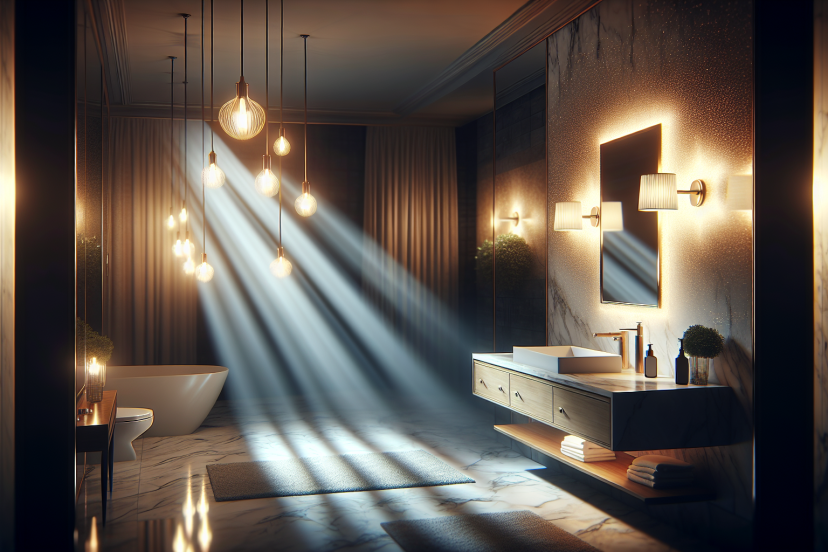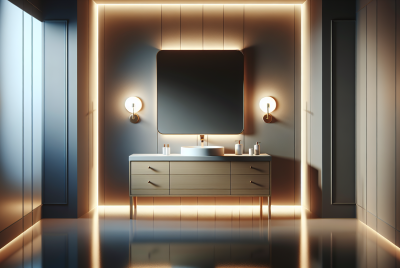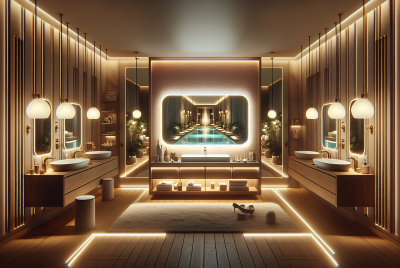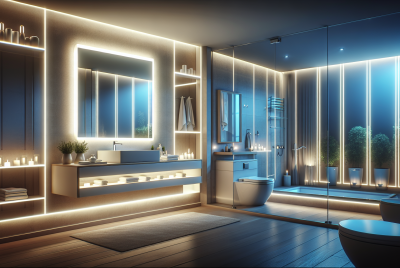Key Factors To Consider When Buying Bathroom Lighting
Are you in the process of renovating your bathroom and looking for the perfect lighting to enhance its design and functionality? Look no further! In this article, we will highlight the key factors you need to consider when buying bathroom lighting. From the importance of proper lighting placement to the selection of the right bulb type and fixture style, we have got you covered. So, sit back, relax, and let us guide you through the essential elements that will make your bathroom shine bright like a diamond.
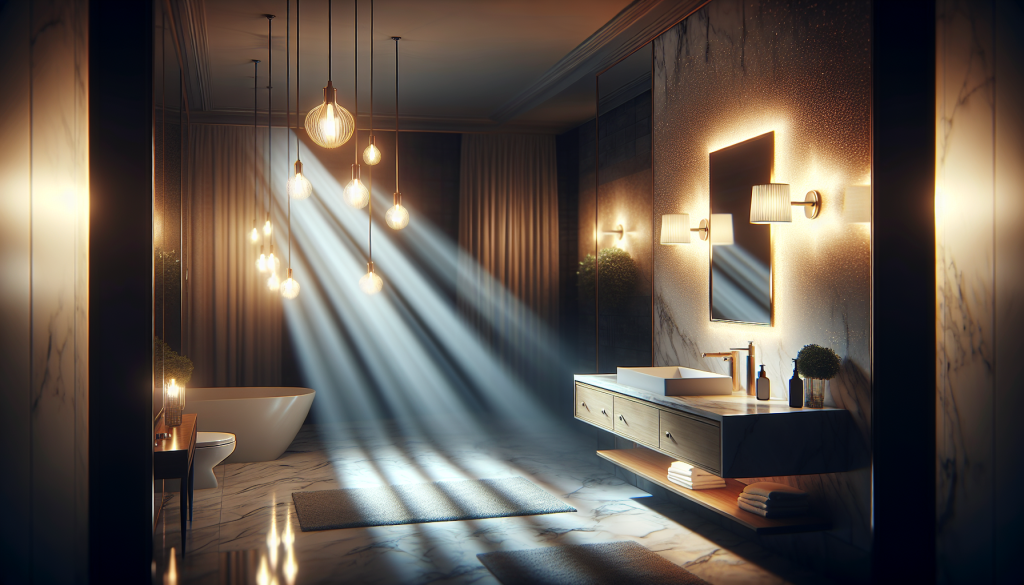
Size and Placement
Size of the Bathroom
When it comes to choosing the right lighting for your bathroom, considering the size of the space is essential. A small bathroom will require different lighting than a larger one. In a small bathroom, you need to be mindful of not overwhelming the space with too many lights. Opt for compact fixtures that provide ample lighting without taking up too much room. In contrast, a larger bathroom may benefit from multiple lighting fixtures strategically placed to provide even illumination throughout the space.
Placement of the Lighting Fixtures
Once you have determined the size of your bathroom, it’s important to consider the placement of the lighting fixtures. The location of your lights can greatly impact the functionality and aesthetics of the space. Task lighting should be positioned near the areas where you perform activities such as applying makeup or shaving. Ambient lighting can be placed above the bathtub or shower area to create a relaxing atmosphere. Accent lighting can highlight architectural features or artwork, while decorative lighting can be used as a statement piece in the overall design of the bathroom.
Lighting Types
Task Lighting
Task lighting is essential in the bathroom, as it ensures proper illumination for activities such as putting on makeup, shaving, or brushing your teeth. Vanity lights located on either side of the mirror are a popular choice for task lighting. They provide even illumination across the face and minimize shadows, allowing you to see clearly and perform these tasks with ease.
Ambient Lighting
Ambient lighting sets the overall mood and atmosphere in the bathroom. It provides a soft, diffused light that creates a welcoming and relaxing environment. Ceiling lights or recessed lighting fixtures are often used as ambient lighting in bathrooms. Placing them strategically throughout the space can help evenly distribute light and eliminate any harsh shadows.
Accent Lighting
Accent lighting adds depth and dimension to your bathroom by highlighting specific areas or objects of interest. It is used to draw attention to architectural features, artwork, or decorative elements. Spotlights or directional wall sconces can be used as accent lighting to create a focal point in the room. By carefully selecting and placing accent lights, you can enhance the visual appeal of your bathroom and create a sense of ambiance.
Decorative Lighting
Decorative lighting serves as both a functional and aesthetic element in your bathroom. It adds a touch of style and personality to the space while providing illumination. Pendant lights or chandeliers are popular choices for decorative lighting in bathrooms. They can be positioned above the bathtub or in the center of the room to create a striking visual impact. When choosing decorative lighting, consider the overall design theme of your bathroom to ensure a cohesive look.
Brightness Level
Purpose of the Bathroom
The purpose of your bathroom plays a significant role in determining the appropriate brightness level of your lighting fixtures. If your bathroom is primarily used for grooming tasks, such as applying makeup or shaving, you will want a brighter light that allows you to see clearly and accurately. In this case, task lighting with a higher brightness level is recommended. On the other hand, if your bathroom is used more for relaxation and unwinding, a softer, more subtle light may be preferable to create a soothing ambiance.
Personal Preference
Personal preference also plays a crucial role in determining the brightness level of your bathroom lighting. Some individuals prefer a well-lit bathroom, while others may prefer a softer, more dimly lit atmosphere. Consider your own preferences and how you use the space to determine the optimal brightness level for your lighting fixtures. Dimmer switches can be a great addition as they allow you to adjust the brightness according to your mood or needs at any given time.
Color Temperature
Warm White
Warm white lighting has a soft, yellowish hue that creates a cozy and inviting atmosphere. It is often associated with traditional or rustic bathroom designs. Warm white light is typically used in areas where relaxation and comfort are paramount, such as near bathtubs or in spacious shower enclosures. It can also complement warmer color schemes and natural materials, such as wooden accents or earth-toned tiles.
Cool White
Cool white lighting has a crisp, bright white color that resembles daylight. It is commonly used in contemporary and modern bathroom designs. Cool white light provides a clean and refreshing ambiance that is great for task-oriented areas, such as vanity mirrors or shower spaces. It can also make small bathrooms appear larger and more spacious. Cool white lighting pairs well with cooler color palettes, such as shades of blue or gray.
Daylight
Daylight lighting mimics natural sunlight and has a bright, refreshing feel. It closely resembles the color temperature of daylight and is often used as a source of general illumination in bathrooms. Daylight bulbs can help create a bright and vibrant setting, making them ideal for bathrooms with large windows or limited natural light. They can also enhance the accuracy of color representation, making them a good choice for those who require precise color perception in their bathroom activities.
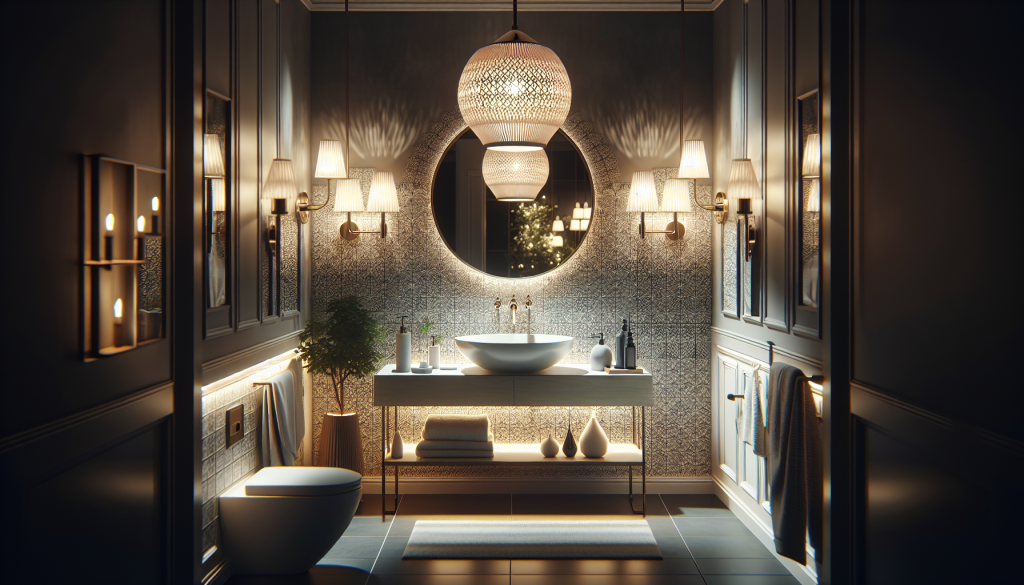
Lighting Fixtures
Wall Sconces
Wall sconces are versatile and practical lighting fixtures that can be used in various locations within the bathroom. They are typically mounted on the walls at eye level to provide flattering and even lighting. Wall sconces come in a wide range of styles and designs, making it easy to find one that complements your bathroom decor. Whether you prefer a sleek and modern look or a more traditional and elegant aesthetic, there is a wall sconce out there to suit your taste.
Vanity Lights
Vanity lights, often placed on either side of the bathroom mirror, are specifically designed to provide functional task lighting. They eliminate shadows and ensure even illumination for grooming activities. Vanity lights are available in different sizes, shapes, and finishes, allowing you to find the perfect match for your bathroom style. Opt for vanity lights with adjustable features, such as swivel heads or dimming capabilities, to optimize their functionality.
Ceiling Lights
Ceiling lights, also known as overhead lights or flush-mounted fixtures, provide general illumination to the entire bathroom space. They are typically mounted on the ceiling and distribute light evenly throughout the room. Ceiling lights come in various styles, including flush-mount, semi-flush-mount, and pendant lights, allowing you to choose the one that best fits your bathroom design. Consider the height of your ceiling and the size of the room when selecting a ceiling light to ensure proper coverage and proportion.
Mirrors with Built-in Lights
Mirrors with built-in lights are a popular choice for modern bathrooms. They provide both lighting and functionality in one sleek design. These mirrors often feature LED lights integrated into the frame, which can be adjusted for brightness and color temperature. Mirrors with built-in lights are particularly useful for applying makeup or grooming tasks, as they provide even illumination without casting harsh shadows. They can also serve as a statement piece in your bathroom, adding a touch of contemporary flair.
Energy Efficiency
LED Lighting
LED lighting is an energy-efficient and eco-friendly option for bathroom lighting. LED bulbs use significantly less energy than traditional incandescent or fluorescent lights, resulting in lower electricity bills and reduced environmental impact. LED bulbs also have a longer lifespan, meaning you won’t have to replace them as often. Additionally, LED lights produce minimal heat, making them safer to use in the bathroom. Consider incorporating LED lighting into your bathroom design to save energy and money in the long run.
Energy Star Certification
When shopping for lighting fixtures, look for those with the Energy Star certification. This certification indicates that the product meets strict energy efficiency guidelines set by the Environmental Protection Agency (EPA). Energy Star-certified fixtures not only consume less energy but also meet high-performance standards, ensuring quality and longevity. By choosing Energy Star-certified bathroom lighting, you can be confident that you are making an environmentally conscious choice without compromising on performance or style.
Motion Sensors
Installing motion sensors in your bathroom can further enhance energy efficiency. These sensors detect movement and automatically turn on the lights when someone enters the room. Once the room is empty, the lights will automatically switch off after a certain period of time. This eliminates the need to manually turn on and off the lights, reducing energy waste. Motion sensors are especially useful in frequently used bathrooms or for households with family members who may forget to switch off the lights when leaving the room.
Water Resistance
IP Rating
When selecting lighting fixtures for the bathroom, it is crucial to consider their water resistance capabilities. The IP (Ingress Protection) rating is used to specify the level of protection a fixture has against the intrusion of solid objects and liquids. Look for fixtures with a high IP rating, such as IP44 or higher, as these are designed to withstand the moisture-rich environment of the bathroom. Higher IP ratings provide better protection against water splashes, ensuring the longevity and safety of your lighting fixtures.
Damp Locations
Damp locations in the bathroom include areas that may experience occasional moisture, such as above the bathtub or near the shower. For these areas, lighting fixtures with a damp location rating are recommended. These fixtures are designed to withstand humidity and moisture without compromising their performance or safety. Damp location-rated fixtures typically have extra seals and gaskets to prevent water from entering the electrical components, ensuring their durability and longevity.
Wet Locations
Wet locations in the bathroom refer to areas that are directly exposed to water, such as inside the shower or above the sink. In these areas, it is essential to select lighting fixtures specifically designed for wet locations. These fixtures have a high level of water resistance and are built to withstand direct contact with water without posing any safety risks. Wet location-rated fixtures are usually sealed and gasketed to prevent water ingress, ensuring safe and reliable operation in these areas.
Style and Design
Matching the Bathroom Decor
When choosing bathroom lighting, it’s important to consider the overall decor and style of the space. You want the lighting fixtures to complement the existing design elements and contribute to the overall aesthetic. If your bathroom has a more traditional or vintage look, opt for fixtures with ornate detailing and warm finishes. For a modern or contemporary bathroom, sleek and minimalist fixtures with clean lines and brushed metal finishes may be more suitable. By selecting lighting fixtures that match the bathroom decor, you can create a cohesive and harmonious design.
Lighting Fixture Styles
Bathroom lighting fixtures come in a wide range of styles, allowing you to find the perfect fit for your personal taste. From traditional and transitional to modern and industrial, there is a style to suit every preference. Consider the existing fixtures and finishes in your bathroom, such as faucets, cabinet hardware, and towel bars, and choose lighting fixtures that complement these elements. Coordinating the styles and finishes of your fixtures can create a cohesive look and enhance the overall design of your bathroom.
Installation Process
DIY vs Professional Installation
The installation process for bathroom lighting can vary depending on the complexity of the fixtures and your level of expertise. Simple fixtures, such as vanity lights or wall sconces, can often be installed as a DIY project. However, if you are unfamiliar with electrical work or if the fixtures are more complex, it is recommended to hire a professional electrician for installation. They have the knowledge and expertise to ensure a safe and proper installation, minimizing the risk of electrical issues or damage.
Electrical Wiring Considerations
Before installing new lighting fixtures, it is important to consider the electrical wiring in your bathroom. Ensure that your electrical system can handle the additional load of the new fixtures without overloading the circuit. If needed, consult with an electrician to assess your wiring and make any necessary upgrades or modifications. Additionally, make sure to comply with local building codes and regulations regarding electrical installations in bathrooms. This will ensure that your lighting fixtures are installed safely and to the appropriate standards.
Budget
Cost of Lighting Fixtures
When planning your bathroom lighting project, it is essential to consider your budget. Lighting fixtures can vary greatly in price, so it is important to establish a budget range before making any purchases. Factors that can influence the cost of fixtures include the brand, design, materials, and additional features. While it is tempting to opt for the most affordable option, remember that lighting fixtures play a crucial role in the functionality and aesthetics of your bathroom. Investing in high-quality fixtures can ensure a long-lasting and visually appealing result.
Operating Costs
In addition to the upfront cost of lighting fixtures, it is important to consider the long-term operating costs. Traditional incandescent bulbs and fluorescent lights are generally less energy-efficient and have a shorter lifespan compared to LED bulbs. LED lighting is known for its energy efficiency and longevity, resulting in lower electricity bills and reduced maintenance costs. When estimating the operating costs, take into account factors such as the wattage of the bulbs, the number of fixtures, and the average usage time. By opting for energy-efficient lighting, you can save money in the long run while minimizing your environmental impact.
In conclusion, choosing the right bathroom lighting involves considering various factors such as the size and placement of the lighting fixtures, the type of lighting needed, the desired brightness level, and the color temperature. Additionally, factors such as energy efficiency, water resistance, style, and installation process need to be taken into account. By carefully considering these key factors, you can create a well-lit and aesthetically pleasing bathroom environment that meets your functional needs and personal preferences. Remember to establish a budget and prioritize energy-efficient options to make the most of your bathroom lighting investment.

